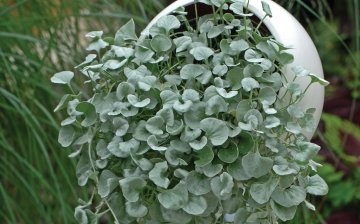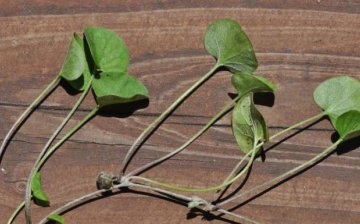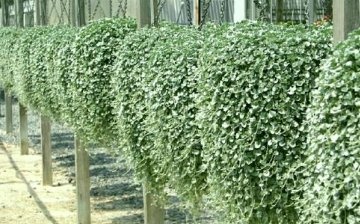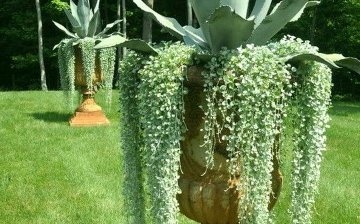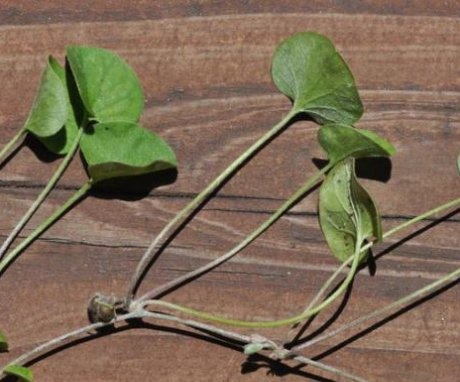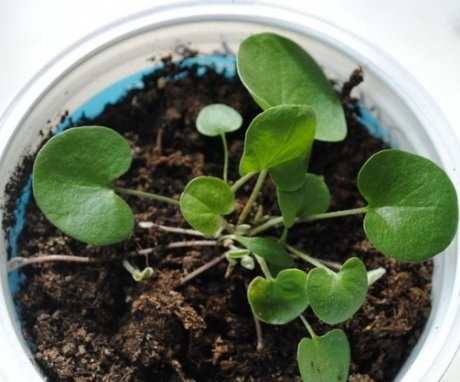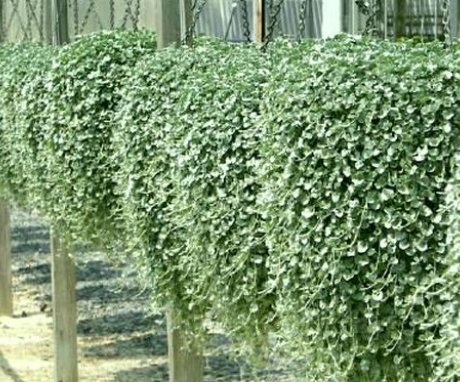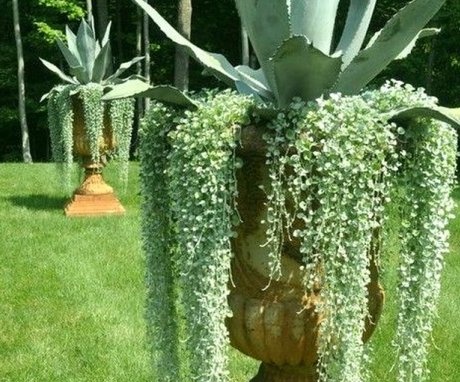Dichondra ampelous: unpretentious liana for the garden
Dichondra is one of the best options for decorating rooms and especially open spaces. The sophistication and beauty of the plant makes it possible to use it to decorate balconies, verandas and outdoor terraces. The variety of plant species provides ample opportunities for choosing a suitable style of building decoration. The plant is readily used to decorate architectural forms.
Content:
- Description of the plant
- Dichondra breeding methods
- Landing technique: terms and rules
- How to properly care for a plant
- Application
Description of the plant
Dichondra is a wonderful ampelous plant that has been growing for many years. The distribution area is marshlands and humid areas. In nature, the species reaches one and a half meters and develops into creeping stems. It is these stems that are valuable for landscape design.
Dichondra has especially spectacular vines. During development, they are covered with dense small foliage, and also have a silky edge. Each variety has its own characteristics that distinguish them and create a choice for buyers.
In modern horticulture, this species is also popular due to the large variety of species, the exact number of which is still unknown. In practice, 2 varieties are most often used:
- The Emerald Vinopad variety does not have the longest stems, and the leaves are only 3 mm long. The flowers, which adorn the entire stem with their small buds, bloom throughout the summer. The plant comes from New Zealand. At home, by the way, the species is considered a weed and gardeners are fighting a merciless battle with it. In many regions of the world, dichondra is a popular lawn type. It does not require a haircut and provides a beautiful appearance. The active growth and formation of dense stems opens up opportunities for the creation of spectacular garden sculptures of various shapes. They are often also used to form natural fences and barriers. "Emerald Falls" prefers shaded places, but in some cases it can develop normally in places exposed to sunlight. To stimulate growth, it is required to spray the dense foliage daily in order to normalize the processes taking place inside the stems. As a rule, subject to the simplest recommendations, gardeners manage to achieve excellent results in growing dichondra.
- The second type, which designers and lovers of ornamental plants love so much, is called “Silvery waterfall". Obviously, the term waterfall is not found in the names by chance - it emphasizes the size and shape of the plant. The silvery leaves of the plant are distributed evenly on the elongated branches. It is used as a potted plant for the decoration of various premises, as well as gardens, open loggias and gazebos. When planting and placing a bush, it is required to take into account that the lighting should be uniform and constant, but not excessive. You should also avoid shaded areas, because in them the foliage significantly loses in aesthetic parameters.
Dichondra breeding methods
This type of plant, as already mentioned, is easy to care for and does not require particularly complex planting steps. Reproduction of the species is carried out in 2 most popular ways:
- Branch layering.
- Plant seeds.
When propagating by layering, several basic rules must be observed:
- Cut off the layers in spring or autumn. Approximately 5-7 cuttings are harvested, which are placed in a container with water.
- After the first roots appear in the water, young stems should be planted in the ground, which is pre-prepared and placed in 3 pieces.
- And only a month later, when the plant gets a little stronger, it is transplanted into a prepared pots or pot, which will become its permanent place for growth and development.
When planting dichondra seeds work begins at the end of January - February. The decisive factor is the desired planting period in natural conditions and the achievement of the greatest flowering. After the first shoots appear, you will have to wait about 4 months until the plant reaches its optimal size. If you want to reach the maximum size in May, then you should start planting in January.
When working with dichondra seeds, you should definitely follow some rules:
- The depth of planting seeds in the ground should not be more than 5 mm.
- The composition of the soil includes a fertile part and sifted sand.
- After watering and dusting with earth, the seeds are additionally covered with glass or prepared polyethylene.
In the process of development, the stems are gradually pressed to the ground, which stimulates the development of new roots. In general, the shape of the plant can be different, which attracts designers. The variety "Emerald Waterfall" in most cases is used for decoration lawns... The soil is carefully prepared in the selected area, dug up and moistened. After that, seeds are placed in it. When sowing, 10 grams of seeds are required for every square meter of soil.
Landing technique: terms and rules
Ampel dichondra reproduces, as already mentioned, in two ways - cuttings and seeds. When grown from seed, the process is a little more tedious and time-consuming. And the shoots are not so easy to find, in view of only the growing popularity of the species.
Sowing work should start in January - this ensures that a full-fledged plant is obtained in May.
The balcony or outdoor terrace will be completely covered with fresh green vines for the hot summer. After planting in the prepared soil, you should wait 4 months before the finished plant is formed.
The soil must be prepared for transplanting. To do this, thoroughly mix the same parts of fertile soil and sand. The seeds are placed in the soil, watered with water, sprinkled with earth and then covered with polyethylene - this way it is possible to avoid moisture evaporation. The container with seeds is moved to a warm place where the air temperature should not drop below 25 degrees Celsius. It is this indicator that guarantees the stable development of dichondra.
How to properly care for a plant
In its natural habitat, dichondra grows on waterlogged soils, so the drying of the soil significantly inhibits the development of the organism. Also, you cannot take the pot out into an open space until the temperature stabilizes at a level of 16 to 26 degrees Celsius.
The growth of herbaceous vegetation of this type is possible on any type of soil. The best option is a drained loamy soil, which provides a moderate accumulation of moisture and prevents root rot.
It is the stagnation of water in the upper soil horizons that ensures the destruction of the surface roots.
If it is possible to preserve the plants and ensure the correct observance of all the established rules, then the dichondra can remain aesthetically pleasing for 5-7 years:
- Be sure to monitor the moisture content of the earthy coma, which contains the seed. Watering best done in the evening to prevent leaf burns. Also, to approximate the conditions to the characteristics of natural growing conditions, the foliage should be periodically sprayed.
- For stable development, an important factor is additional soil nutrition with special fertilizers. It is recommended to feed the dichondra with a special feeding and once a week. As a rule, nitrogen-containing fertilizer alternates and organic matter.
- An important characteristic of the plant is the large number of branches, which creates different types of garden structures and different hanging branches. To stimulate plant growth, use the technique trimming branches as winter approaches. Usually they are cut by 7 cm, which ensures the rapid growth and development of new branches.
- For the autumn-winter period, the kutas must be moved indoors. Watering is reduced because the plant needs less water. But it is also impossible to completely stop watering, since the plant may die. Top dressing for the root system is applied no more than once a month.
- Ampel dichondra is relatively resistant to pests and various diseases. It quickly adapts to specific growing conditions and reaches its size without problems. The protective system is built in such a way as to securely anchor itself in the allotted space and to withstand the attack of pests. Sometimes, high soil moisture can lead to the development of nematodes. This disease is quite difficult to cure, so it is more rational to monitor the moisture content in the soil.
Application
Dichondra is actively used for decorative decoration of country houses, parks and alleys. When planting plants, take into account that it is rapidly increasing in size, providing real thickets of vines on the site. Therefore, the expected natural design should be planned in advance.
Sometimes the plant is used to cover the soil with a protective layer.
Silver dichondra has a very water-like appearance, which makes it suitable for simulating water flow in a variety of situations. This view looks especially impressive when exposed to sunlight, which creates unusual overflows.
Experienced florists create stunning combinations of different flowers and herbs with dichondra. When decorating a personal plot, it should be remembered that the view can also be used for home cultivation, because an unusual and interesting result can be obtained within an apartment.
More information can be found in the video:




